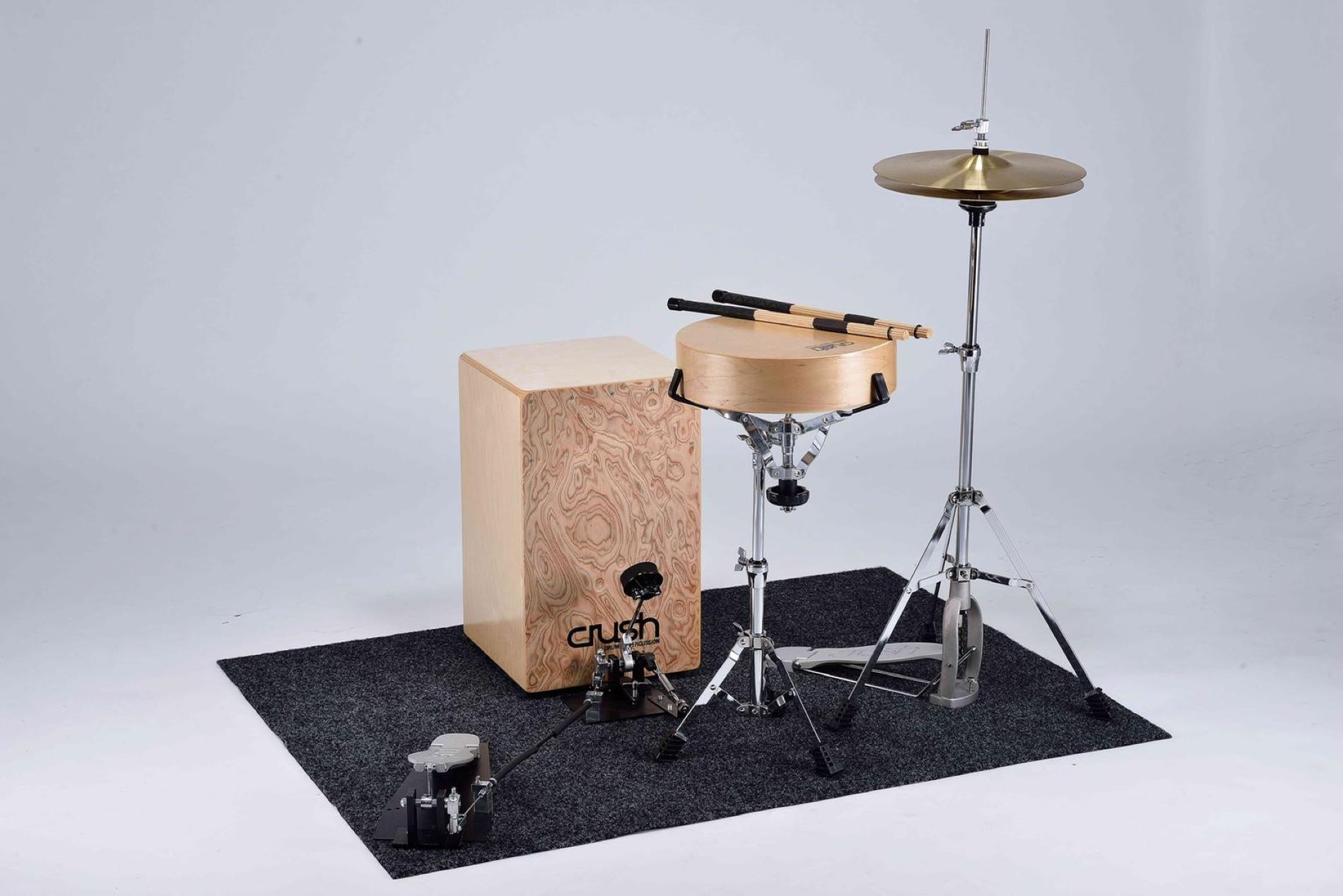Home>Instruments>Drums>How To Play Beats On The Drums


Drums
How To Play Beats On The Drums
Published: February 8, 2024
Learn how to play beats on the drums with our step-by-step guide. Master the art of drumming and improve your rhythm skills today! Discover expert tips and techniques.
(Many of the links in this article redirect to a specific reviewed product. Your purchase of these products through affiliate links helps to generate commission for AudioLover.com, at no extra cost. Learn more)
Table of Contents
Introduction
Introduction
Playing the drums is an exhilarating and rewarding experience. Whether you're a beginner or an experienced musician, the rhythmic pulse of the drums can captivate both the player and the audience. Learning how to play beats on the drums opens up a world of musical possibilities, allowing you to express yourself through rhythm and create a solid foundation for any musical ensemble.
Mastering drum beats requires a combination of technique, coordination, and creativity. From laying down a steady rock beat to exploring complex jazz rhythms, the drums provide a dynamic platform for musical expression. In this guide, we'll delve into the essential aspects of playing beats on the drums, covering basic techniques, coordination development, playing different styles, and adding fills and variations to elevate your drumming skills.
Whether you're drawn to the driving force of rock, the syncopated grooves of funk, or the intricate patterns of jazz, the fundamentals of drumming remain consistent. By understanding and practicing these fundamentals, you can lay a solid groundwork for your drumming journey. So, grab your drumsticks, sit behind the kit, and let's explore the art of playing beats on the drums.
Understanding Basic Drum Beats
Understanding Basic Drum Beats
Before diving into complex rhythms and intricate patterns, it’s crucial to grasp the fundamentals of basic drum beats. These foundational rhythms form the backbone of countless songs across various genres, serving as the driving force behind the music. At the core of basic drum beats lies the concept of timekeeping and groove, which are essential for any drummer.
One of the most common basic beats is the four-on-the-floor pattern, often associated with rock and pop music. This pattern emphasizes the four beats in a measure, with the bass drum striking on each downbeat, creating a steady and driving rhythm. Another fundamental beat is the backbeat, where the snare drum accentuates beats two and four, adding a strong emphasis to the groove.
Understanding the role of each drum within a basic beat is crucial for developing a solid rhythmic foundation. The hi-hat, for example, plays a vital part in maintaining the pulse of the beat, whether in an open or closed position. Meanwhile, the bass drum provides the low-end thump, anchoring the rhythm and establishing the song’s feel.
As you delve into basic drum beats, it’s essential to focus on consistency, dynamics, and precision. Developing a keen sense of timing and control over your drum strokes will set the stage for more advanced techniques down the road. Moreover, practicing basic beats with a metronome can significantly enhance your internal sense of tempo and groove, leading to tighter and more confident drumming.
Mastering basic drum beats lays the groundwork for exploring diverse styles and genres, allowing you to adapt and evolve your drumming skills. Whether you’re drawn to the infectious energy of funk, the driving force of rock, or the syncopated patterns of jazz, a solid understanding of basic drum beats will serve as a springboard for your musical journey.
Developing Coordination
Developing Coordination
Coordination is a fundamental aspect of drumming that encompasses the seamless integration of limb movements to produce cohesive and expressive rhythms. As a drummer, honing your coordination skills is essential for navigating complex patterns, executing dynamic fills, and maintaining a steady groove. Whether you’re a novice or seasoned drummer, dedicating time to coordination development can significantly elevate your playing.
One key element of coordination development is limb independence, which involves training each limb to operate independently while contributing to the overall rhythm. This skill is particularly crucial for executing polyrhythmic patterns, where different limbs play contrasting rhythms simultaneously. Practicing exercises that isolate each limb, such as playing different rhythms with the hands and feet, can enhance limb independence and bolster coordination.
Rudiments, the fundamental sticking patterns used in drumming, also play a pivotal role in coordination development. By practicing a diverse array of rudiments, ranging from single strokes and double strokes to paradiddles and flams, drummers can refine their hand technique and bolster coordination between the hands. Moreover, incorporating rudiments into drum beats and fills adds depth and dexterity to your playing, enriching your rhythmic vocabulary.
Another aspect of coordination development involves integrating the use of the drum kit’s various components, including the snare drum, bass drum, hi-hat, toms, and cymbals. By orchestrating cohesive patterns across these components, drummers can create dynamic and multifaceted rhythms that enhance the musical landscape. This integration fosters a deeper understanding of the instrument’s capabilities and expands the creative possibilities within drumming.
Furthermore, engaging in cross-training activities, such as practicing hand-foot coordination exercises and incorporating elements of other percussion instruments, can broaden your rhythmic horizons and fortify your coordination skills. These activities not only challenge your dexterity but also infuse your playing with new textures and dynamics, enriching your musical expression.
Ultimately, developing coordination is an ongoing journey that demands patience, dedication, and deliberate practice. By nurturing your limb independence, mastering rudiments, integrating drum kit components, and embracing cross-training activities, you can cultivate a robust foundation of coordination that empowers you to explore and excel in various musical contexts.
Playing Different Styles
Playing Different Styles
Drumming is a versatile art form that encompasses an array of styles, each with its distinct rhythmic characteristics and expressive nuances. As a drummer, delving into different styles not only broadens your musical repertoire but also nurtures adaptability and creativity. Whether you’re drawn to the infectious grooves of funk, the driving force of rock, the syncopated patterns of jazz, or the dynamic beats of world music, exploring diverse styles enriches your drumming journey.
Funk drumming is renowned for its emphasis on syncopation, groove, and dynamic interplay between the bass drum, snare drum, and hi-hat. Mastering the art of funk drumming involves cultivating a deep pocket, locking in with the bass player, and incorporating rhythmic variations to propel the music forward. The use of ghost notes, intricate hi-hat patterns, and off-beat accents distinguishes funk drumming and infuses it with infectious energy.
Rock drumming, characterized by its powerful and driving rhythms, forms the backbone of countless iconic songs. From classic rock to hard rock and beyond, rock drumming demands a solid backbeat, commanding fills, and an unwavering sense of power and energy. Whether you’re laying down thunderous grooves or executing explosive drum fills, rock drumming embodies raw intensity and rhythmic prowess.
Jazz drumming, with its emphasis on improvisation, swing feel, and intricate cymbal work, invites drummers to explore boundless rhythmic possibilities. From delicate brush patterns to propulsive ride cymbal ostinatos, jazz drumming demands a keen sense of dynamics, sensitivity, and adaptability. Navigating through swing, bebop, and fusion styles, jazz drummers craft intricate and evolving rhythmic landscapes that elevate the musical conversation.
Exploring world music styles, such as Latin, African, and Caribbean rhythms, introduces drummers to a rich tapestry of cultural influences and rhythmic traditions. Whether delving into the pulsating rhythms of Afro-Cuban music, the polyrhythmic textures of West African drumming, or the vibrant grooves of Brazilian samba, embracing world music styles expands your rhythmic vocabulary and fosters a deeper appreciation for global musical heritage.
By immersing yourself in different styles, you not only expand your rhythmic repertoire but also cultivate a versatile and adaptable approach to drumming. Embracing the nuances of funk, rock, jazz, world music, and beyond empowers you to infuse your playing with diverse influences, enriching your musical expression and connecting with a myriad of audiences and musical collaborators.
Adding Fills and Variations
Adding Fills and Variations
As a drummer, incorporating fills and variations into your playing not only adds excitement and flair to your performance but also showcases your creativity and musicality. Fills, in particular, serve as embellishments within a song, punctuating transitions, and adding rhythmic accents. Whether executing explosive drum fills in a rock anthem or crafting subtle embellishments in a jazz ballad, mastering the art of fills and variations elevates your drumming to new heights.
When integrating fills into your drumming, it’s essential to consider musical context, dynamics, and timing. Fills should complement the song’s structure, enhancing climactic moments, transitioning between song sections, and adding rhythmic color. By aligning fills with the song’s dynamics and phrasing, drummers can create seamless and impactful transitions that captivate listeners and propel the music forward.
Exploring a diverse array of fill patterns, from basic to intricate, empowers drummers to infuse their playing with dynamic textures and rhythmic surprises. By incorporating rudiments, such as paradiddles, flams, and drag rolls, into fills, drummers can add depth and complexity to their rhythmic arsenal. Moreover, experimenting with varying subdivisions and accents within fills amplifies their impact and injects a sense of rhythmic intrigue.
Variations within drum beats offer opportunities to infuse creativity and spontaneity into your playing. By subtly altering the pattern, adding ghost notes, or introducing syncopated accents, drummers can breathe new life into familiar grooves, keeping the music fresh and engaging. Additionally, embracing asymmetrical phrasing and metric modulations within variations fosters a sense of unpredictability and excitement, captivating both the audience and fellow musicians.
Furthermore, understanding the interplay between fills, variations, and the overall musical landscape is paramount. By listening attentively to the music, communicating with bandmates, and embracing improvisational moments, drummers can seamlessly integrate fills and variations, enhancing the collective musical experience. This collaborative approach cultivates a dynamic and responsive musical dialogue, enriching the rhythmic tapestry of the ensemble.
Ultimately, mastering the art of adding fills and variations requires a balance of technical proficiency, creativity, and musical sensitivity. By honing your ability to craft compelling fills, experiment with rhythmic variations, and synchronize seamlessly within the musical context, you can elevate your drumming to a level of expressive and captivating artistry.
Conclusion
Congratulations on embarking on the rhythmic journey of playing beats on the drums. From understanding basic drum beats to developing coordination, exploring different styles, and adding fills and variations, you’ve delved into the multifaceted world of drumming, honing your skills and expanding your musical horizons.
As you continue your drumming odyssey, remember that patience, perseverance, and passion are your steadfast companions. Embrace the nuances of rhythm, immerse yourself in diverse musical styles, and cherish the creative freedom that drumming offers. Whether you’re crafting thunderous rock grooves, navigating intricate jazz patterns, or infusing infectious funk energy, your rhythmic voice is a vital thread in the fabric of music.
Furthermore, never underestimate the power of collaboration and musical dialogue. Drumming is not just about keeping time; it’s about engaging in a rhythmic conversation with fellow musicians, responding to the ebb and flow of the music, and collectively shaping sonic landscapes. Embrace the synergy of the ensemble, listen intently, and let your rhythmic contributions elevate the musical tapestry.
As you navigate the exhilarating terrain of drumming, remember that your journey is as unique as your rhythmic fingerprint. Cultivate your individuality, experiment with new techniques, and let your creativity flourish. Whether you’re crafting intricate fills, exploring polyrhythmic textures, or anchoring a pulsating groove, your rhythmic expression is a testament to the artistry of drumming.
In conclusion, the world of drumming is a boundless realm of rhythm, expression, and creativity. As you harness the power of beats on the drums, may your rhythmic odyssey be filled with joy, discovery, and rhythmic resonance. Embrace the heartbeat of the drums, let your rhythm reverberate through the music, and revel in the transformative power of drumming.











